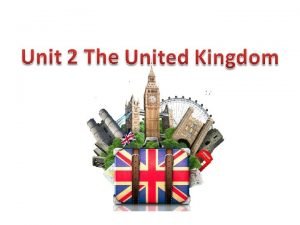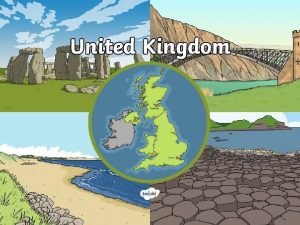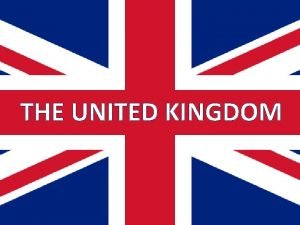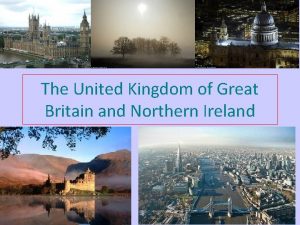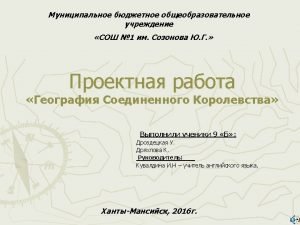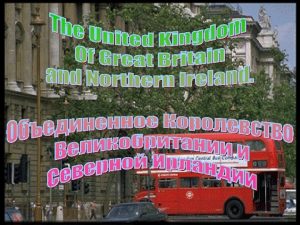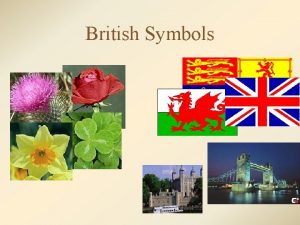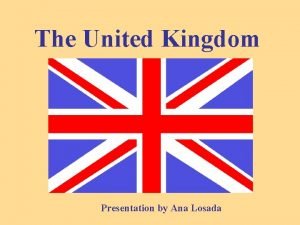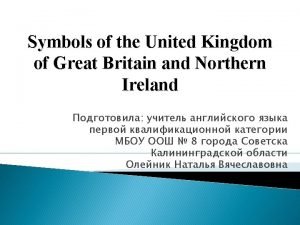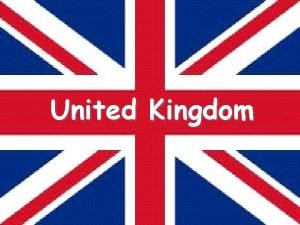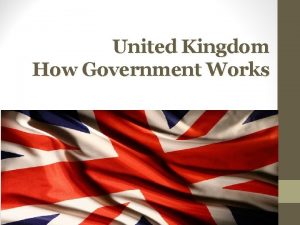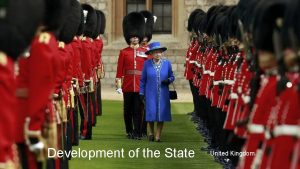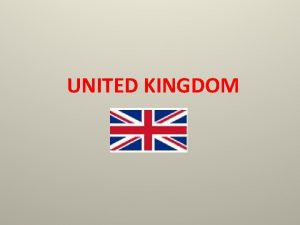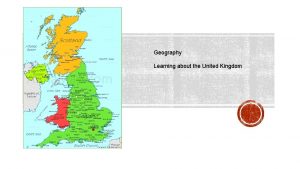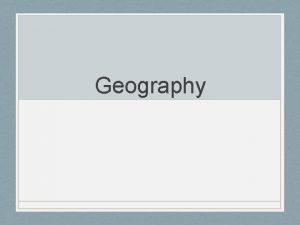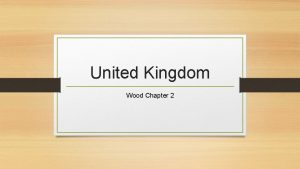Geography of the United Kingdom Geography location The




















- Slides: 20


Geography of the United Kingdom

Geography location The United Kingdom occupies a substantial part of the British Isles. The United Kingdom of Great Britain and Northern Ireland, or UK, is in Western Europe. It comprises the island of Great Britain (England, Scotland Wales) and the northeastern one-sixth of the island of Ireland (Northern Ireland), together with many smaller islands. The mainland areas lie between latitudes 49°N and 59°N (the Shetland Islands reach to nearly 61°N), and longitudes 8°W to 2°E. The Royal Greenwich Observatory, near London, is the defining point of the Prime Meridian. The United Kingdom has a total area of approximately 245, 000 km². The UK lies between the North Atlantic Ocean and the North Sea, and comes within 35 km (22 miles) of the northwest coast of France, from which it is separated by the English Channel. Northern Ireland shares a 360 km international land boundary with the Republic of Ireland. The Channel Tunnel ("Chunnel") bored beneath the English Channel, now links the UK with France.


Physical geography The physical geography of the UK varies greatly. It includes the chalk cliffs of Kent and Dorset, the rolling hills and fields of southeast England, the granite cliffs of Cornwall, the mountains of Wales, the uplands of the Peak District and the Pennines, the lakes and mountains of Cumbria, the Scottish lowlands, highlands and islands, and the fields, lakes and mountains of Northern Ireland. The country can be roughly divided into highland lowland along the Tees-Exe line. The exact centre of the island of Great Britain is disputed. Depending upon how it is calculated it can be either Haltwhistle in Northumberland, or Dunsop Bridge in Lancashire.


Geology The geology of the United Kingdom is varied and complex. This gives rise to the wide variety of landscapes found across the UK. This variety, coupled with the early efforts of UK based scientists and geologists to understand it, has influenced the naming of many geological concepts, including many of the geological periods (for example, the Ordovician period is named after the Ordovices, a people of early Britain; the Devonian period is named after the county of Devon in south-west England). The oldest rocks in the UK are gneisses which date from at least 2, 700 Ma ("Ma" means "millions of years ago") in the Archaean Period, which are found in the far north west of Scotland in the Hebrides, with a few small outcrops elsewhere. South of the gneisses are a complex mixture of rocks forming the North West Highlands and Grampian Highlands in Scotland, as well as the Connemara, Donegal and Mayo mountains of north Ireland. These are essentially the remains of folded sedimentary rock, deposited over the gneiss, from 1, 000 Ma, with a notable 7 km thick layer of Torridon Sandstone being deposited about 800 Ma, as well as the debris deposited by an ice sheet 670 Ma.

Mountains and hills (Горы и Холмы)

Mountains and hills At 1, 344 metres, Ben Nevis is the highest peak in the UK. The ten tallest mountains in the UK are all found in Scotland. The highest peaks in each part of the UK are: ► ► Scotland: Ben Nevis (Nevis Range, 1, 344 metres) Wales: Snowdon (Cambrian Mountains, 1, 085 metres) England: Scafell Pike (Cumbrian Mountains, 977 metres) Northern Ireland: Slieve Donard (Mourne Mountains, 852 metres) The ranges of mountains and hills in the UK include: Scotland: Cairngorms, Cheviot Hills, Scottish Highlands, Southern Uplands, Wales: Brecon Beacons, Cambrian Mountains, Snowdonia, Black Mountains, England: Chilterns, Cotswolds, Dartmoor, Lincolnshire Wolds, Exmoor, Lake District, ► Northern Ireland: Mountains of Mourne, Antrim Plateau, Sperrin Mountains ► ► ► The lowest point of the UK is in the Fens of East Anglia, in England, parts of which lie up to 4 m below sea level.


Rivers and lakes The longest river in the UK is the River Severn (220 miles, 354 km) which flows through both Wales and England. The longest rivers in the UK are: Ш England: River Thames England: (215 miles, 346 km) Ш Scotland: River Tay Scotland: (117 miles, 188 km) Ш N. Ireland: River Bann N. Ireland: (76 miles, 122 km) Ш Wales: River Tywi Wales: (64 miles, 103 km)



Islands In total, it is estimated that the UK is made up of over 1000 small islands, some being natural and some being man-made crannogs, which were built in past times using stone and wood and which were enlarged by natural waste building up over time. Islands of England Islands of Scotland Islands of Wales Ш Lundy Ш Orkney Islands Ш Anglesey Ш Isles of Scilly Ш Skomer Island Ш Isle of Wight Ш Shetland Islands Ш Inner Hebrides Ш Farne Islands Ш Outer Hebrides Ш Ramsey Island Ш Lindisfarne Ш Rockall Ш Bardsey Island Ш Isle of Portland Ш Bass Rock Ш Holy Island Ш Walney Island Ш Skokholm Island


Economic geography The economic geography of the UK reflects not only its current position in the global economy, but its long history both as a trading nation and an imperial power. The UK led the industrial revolution and its highly urban character is a legacy of this, with all its major cities being current or former centres of all forms of manufacturing. However, this in turn was built on its exploitation of natural resources, especially coal and iron ore. Primary industry The UK's primary industry was once dominated by the coal industry, heavily concentrated in the north, the Midlands and south Wales. This is all but gone and the major primary industry is North Sea oil. Its activity is concentrated on the UK Continental Shelf to the north-east of Scotland.


Natural resources Historically, much of the United Kingdom was forested. Since prehistoric times, man has deforested much of the United Kingdom. Agriculture is intensive, highly mechanised, and efficient by European standards, producing about 60% of food needs with only 1% of the labour force. It contributes around 2% of GDP. Around two thirds of production is devoted to livestock, one third to arable crops. The UK has a variety of natural resources including: v Geological: coal, petroleum, natural gas, limestone, chalk, gypsum, silica, rock salt, china clay, iron ore, tin, silver, gold, lead. v Agricultural: arable land, wheat, barley, hill farms, sheep. The UK has large coal, natural gas, and oil reserves; primary energy production accounts for 10% of GDP, one of the highest shares of any industrial nation. Due to the island location of the UK, the country has great potential for generating electricity from wave power and tidal power, although these have not yet been exploited on a commercial basis.


 Old kingdom middle kingdom new kingdom
Old kingdom middle kingdom new kingdom Old kingdom middle kingdom new kingdom
Old kingdom middle kingdom new kingdom Roman empire
Roman empire Old kingdom middle kingdom new kingdom
Old kingdom middle kingdom new kingdom What is the full name of the united kingdom
What is the full name of the united kingdom Great britain and uk difference
Great britain and uk difference United kingdom
United kingdom United kingdom security vetting
United kingdom security vetting United kingdom 5 countries
United kingdom 5 countries What does the united kingdom consist of
What does the united kingdom consist of Uk physical geography
Uk physical geography What consists of the uk
What consists of the uk Floral emblem of england
Floral emblem of england United kingdom coat of arms
United kingdom coat of arms United kingdom presentation
United kingdom presentation Uiuc swb
Uiuc swb National animal uk
National animal uk St thomas of aquin's high school
St thomas of aquin's high school United kingdom hdi
United kingdom hdi House address in united kingdom
House address in united kingdom Kingdom fungi and kingdom plantae similarities
Kingdom fungi and kingdom plantae similarities




